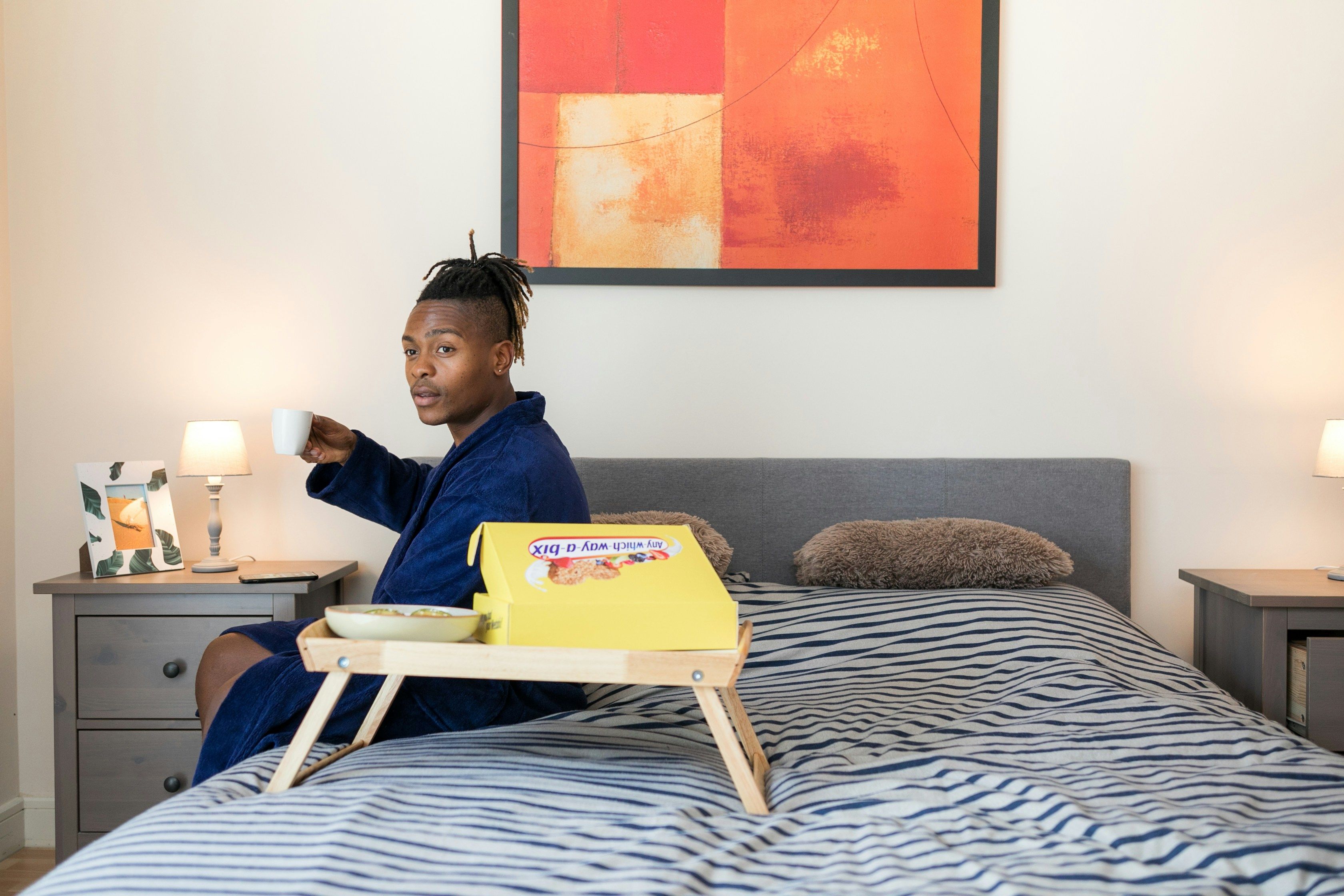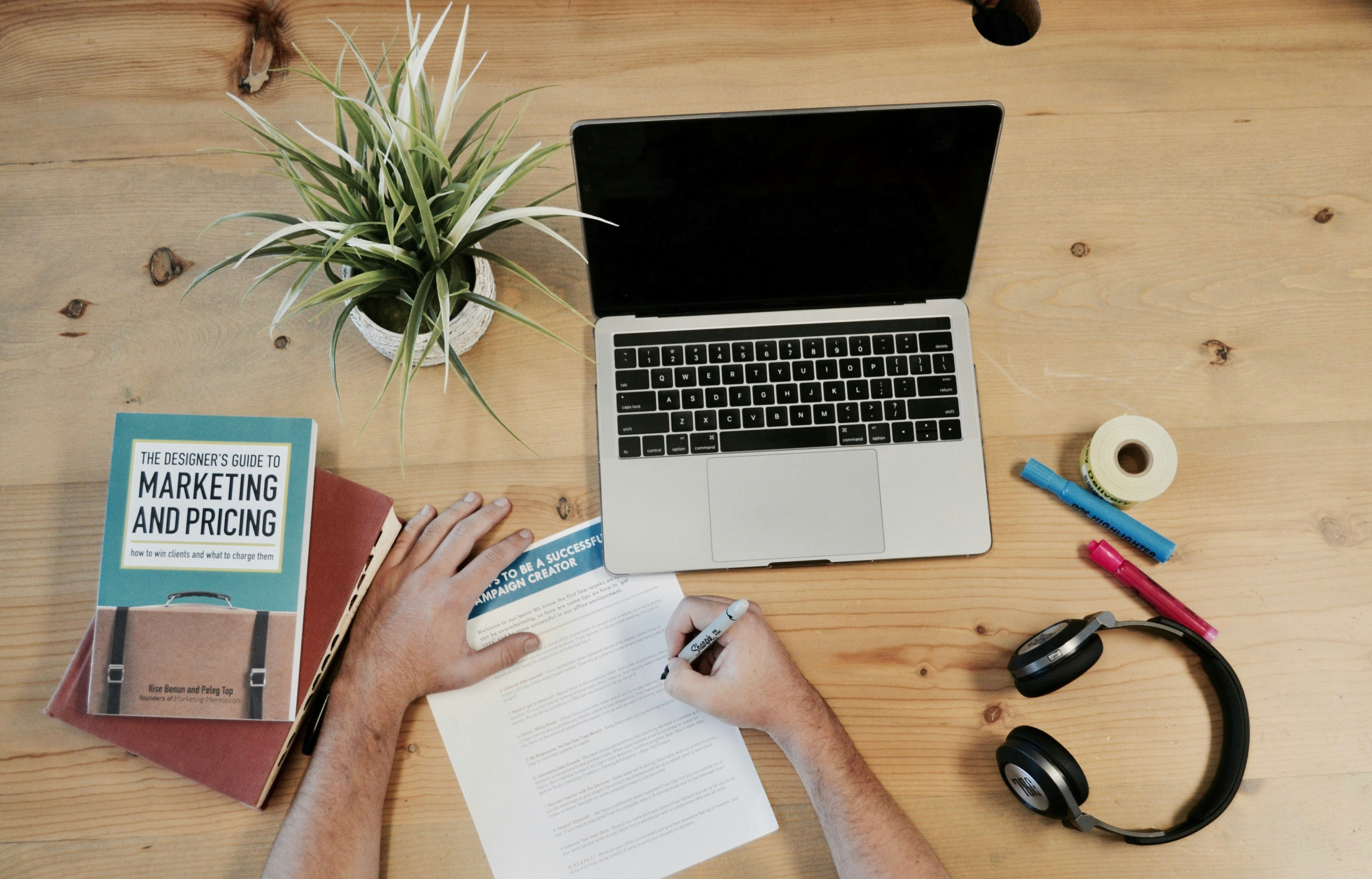“Influencer marketing is dead.”
Rolling Stone published an article with that phrase in the title in 2022. They were wrong then, and they’re wrong now–because in 2024, influencer marketing campaigns are more potent than ever.
According to The State of Influencer Marketing 2024, 63% of marketers reported that their influencer-created content outperformed all other brand-related content.
… And that shouldn’t be surprising, considering influencers are pros at driving engagement and sales.
They’re also fantastic at creating scroll-stopping content for brands to use as UGC, which is sorely needed since people are more skeptical than ever of advertising.
So whether it’s your first time or your hundredth time, it’s time to start some influencer marketing campaigns. Your path to building brand loyalty and connecting with potential clients will be much smoother with some friendly advocates (aka influencers) by your side.
But don’t worry–we won’t spend more time discussing why influencer marketing is alive and well in 2024. After all, there’s work to do!
It’s time for us to walk you through everything you need to know to create a successful influencer marketing campaign for your brand. After we’ve done that, we’ll also show you real-life examples of brands that are rocking their influencer marketing strategy in 2024.
Are you ready? Let’s get started!
What is an influencer marketing campaign?
Simply put, an influencer marketing campaign means you’re working with several influencers over a defined period to achieve a specific goal.
You might run influencer marketing campaigns seasonally. You can use them to launch new products. Or, you can run longer campaigns to grow your brand awareness and get people to talk about your brand.
Let’s say you needed 25 pieces of UGC for a new product launch. You have 2 months to get this content, so you decide to work with about 30 influencers at a rate of 4-5 per week. After all–you want to have some options when it’s time to start posting and running ads, and you know that every piece of content doesn’t always work out how you’d pictured.
Next, you must set the budget, find influencers, and pay them accordingly. There are usually a few other minor details to work out, too, but this is generally how influencer marketing campaigns work.
Here’s an example of influencer marketing so you can see how it works for a real brand:
Much like our previous example, the perfume company Nadra Safiri had a problem: they’d been so focused on creating new home fragrances that they’d forgotten to get their marketing ducks in a row.
They needed UGC for their new product line, and they needed it fast.
Thankfully, Social Cat connected them with influencers in their niche so they could run influencer marketing campaigns targeting brand awareness for their new fragrance line.
Here are the steps they followed:
- First, they signed up for Social Cat.
- Then, they used our influencer matching system to find over 50 influencers they wanted to collaborate with.
- Finally, they shipped their new products to the influencers, and the influencers took it from there–creating over 50 pieces of UGC that Nadra Safiri could use to promote their new home fragrance line!
If you’re hoping to run influencer marketing campaigns for your brand, you can’t go wrong with Social Cat–just ask our thousands of satisfied clients.
How do you define a successful influencer marketing campaign?
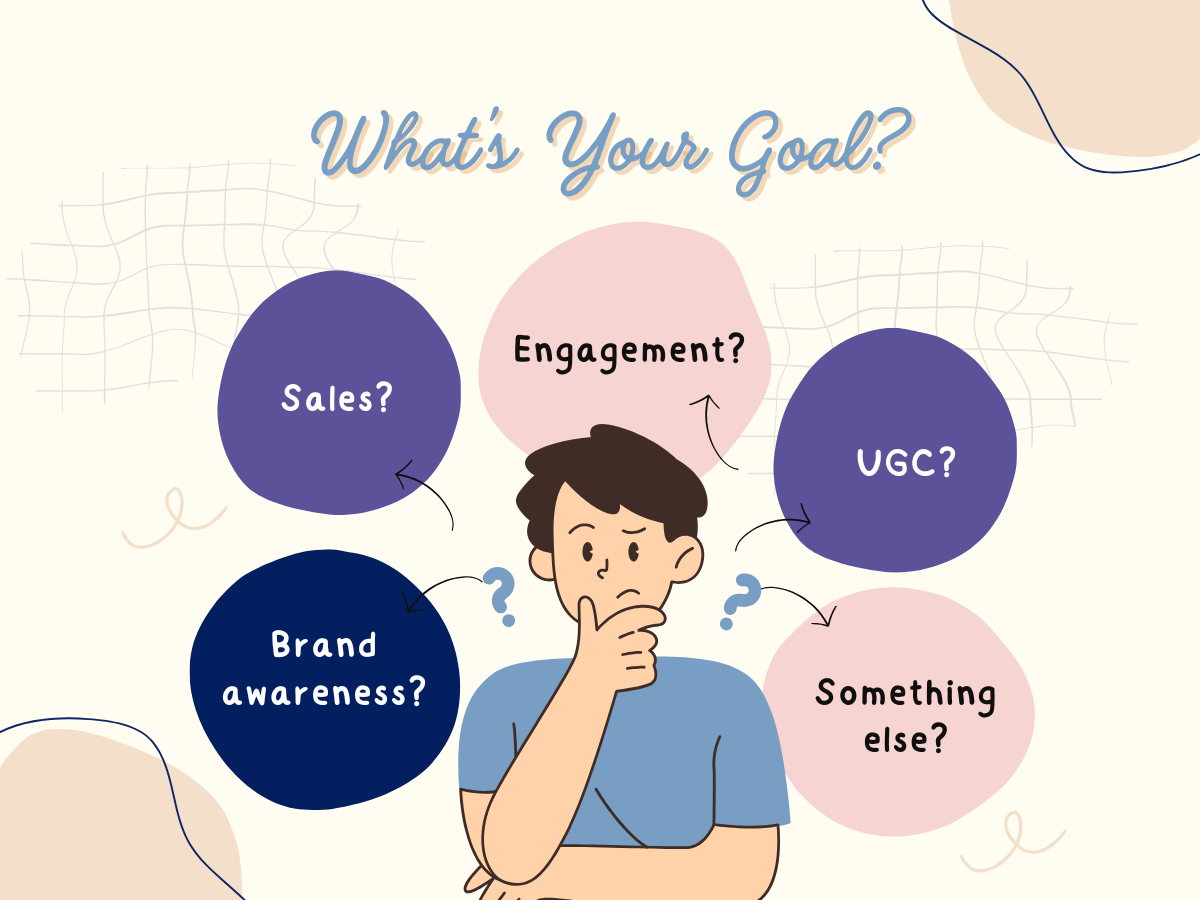
There isn’t one “correct” way to define a successful influencer marketing campaign. As with nearly everything in business, success depends on your original goal.
Typically, you’ll be trying to do one of four things when you’re running influencer marketing campaigns:
- Generate brand awareness through digital PR campaigns
- Drive engagement with your posts on social media
- Create sales
- Get UGC to run in ads or post on your pages
Before you start your influencer marketing campaign, set reasonable SMART goals for it.
A great example could be, “I want to generate 50 pieces of UGC to use on my social media channels in the next 3 months.”
You could also say, “I want to increase my engagement on Instagram by 10% by the end of Q3.”
Write these goals down somewhere you can easily find them after the campaign ends, and keep them in mind. Tracking influencer marketing campaigns can help you see what is–and isn’t–helping you reach your goals so you can adjust your strategy.
Then, compare what happened during the campaign to your original goal. Did it hold up? That will tell you whether or not the campaign was a success.
The influencer marketing strategy you select will define what success looks like for you–so with those goals in mind, here’s what successful influencer marketing campaigns can look like:
Goal: UGC
If your goal is to get more UGC for your brand, ask yourself these questions:
- How many top-quality pieces of content do we need?
- How many did we get in the specified time frame?
For example, a successful influencer marketing case study with the goal of UGC is our client, 1-800-Flowers. They needed UGC for their social media channels and ads, and they quickly got over 100 pieces of UGC!
Goal: Sales
If your goal is to get more sales for your brand, ask yourself these questions:
- How many sales are you currently getting?
- How many more sales would you like to get?
- Did you reach the number of sales you were hoping for?
- How am I going to track sales from influencers? (TIP - use discount codes)
For example, our client Unisoy Jerky used influencer marketing to create a 10% increase in sales!
Goal: Brand Awareness
Brand awareness is more complex to measure and track than UGC or sales. But that doesn’t mean you can’t see improvements!
Measuring the reach of each campaign you run with influencers is one way to track brand awareness. Reach tells you how many unique individual users saw your post or an influencer's post in this case.
If you reached 3,000 users, this means that 3,000 users are now aware your brand exists. Sure, this is an example, but the landscape is more complex than this, so let's keep things simple.
Goal: Engagement
If your goal is more engagement on your brand’s social media posts, ask yourself these questions:
- How much engagement do you currently have?
- What’s your follower count?
- How would you like to see those changes in a specific period?
- Did you see those results after running the campaign?
What are the different types of influencer marketing campaigns?
Just as you can have different goals for your influencer marketing campaigns, you’ll have different influencer content in each one, depending on the products, goals, and influencers involved.
Before you start collaborating with influencers, knowing what type of campaign you’re hoping to run is a good idea. Here are a few of the most popular options:
Product Placement and Sponsorship Campaigns
Product placement ads started with traditional media like movies and TV shows. Instead of running ads about their products and interrupting a movie or show, brands would pay studios to include their product in the production.
In E.T., Elliot famously lures E.T. back to his house with Reese’s Pieces.
It happens so naturally in the movie that you might think that’s an accident–maybe someone involved in the writing process liked Reese’s Pieces?
If you thought that, you’d be wrong. The director, Stephen Spielberg, actually approached M&M’s for sponsorship first. When they turned him down, he asked Reese’s–and Reese’s Pieces sales JUMPED by 70-80% after the movie's release. (Source)
Product placement with influencers happens in much the same way–and they can be some of the most successful influencer marketing campaigns your brand runs.
You ask them to create their typical content–the stuff their followers expect to see–and make your brand part of the story.
Now, on social media, you do often have to say when something is an ad, and the influencers you work with will probably tag you and note that you’re the sponsor of their post. But if an influencer has a dedicated following, there’s nothing like them casually using your products to generate engagement and sales!
Here are some examples of influencer marketing campaigns that used product placement and sponsorship:
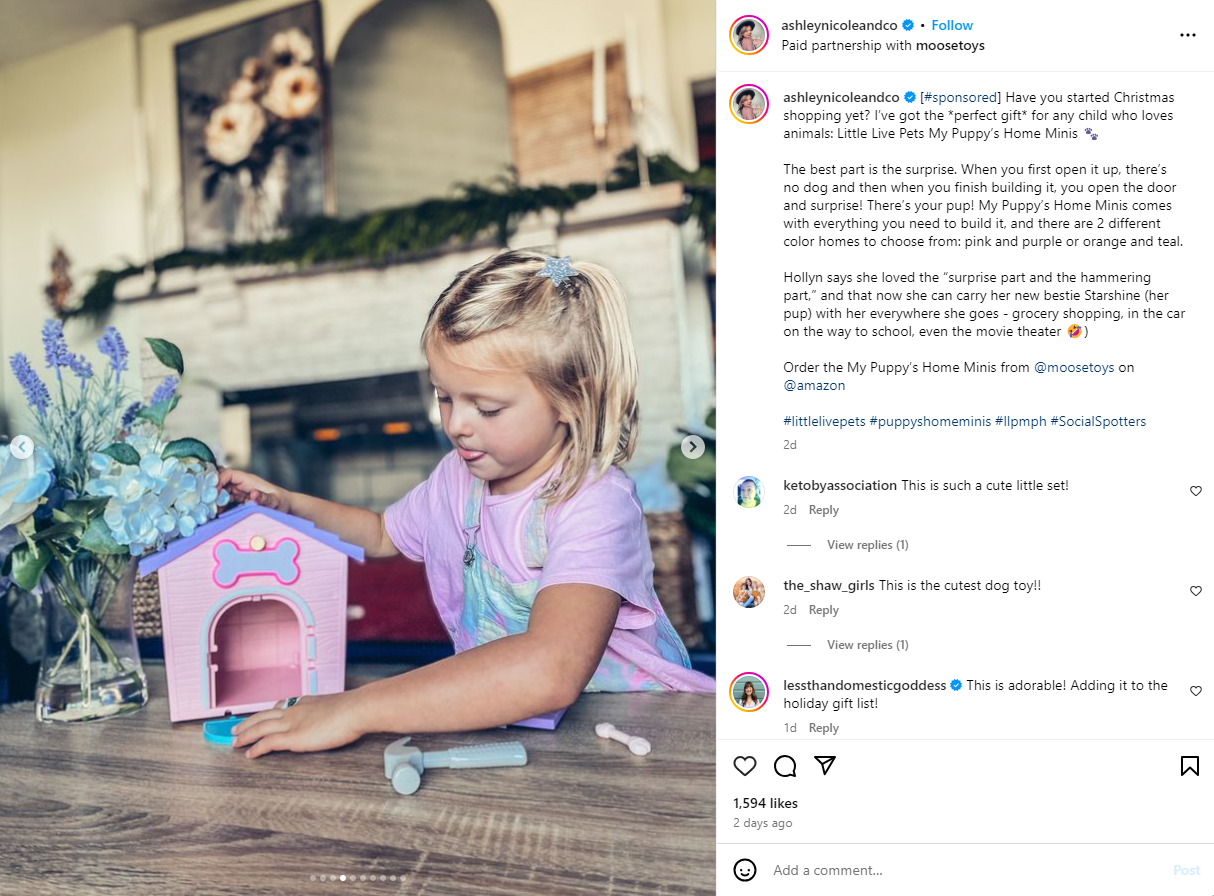
Moose Toys is partnering with micro influencers like @ashleynicoleandco to promote its toys leading up to Christmas. This relatively new post has generated over 1,000 likes—much more than they get on their team’s Instagram product demos. And this isn’t just a fluke–one of the influencer-made posts they reposted on their profile got significantly more likes than their average post.
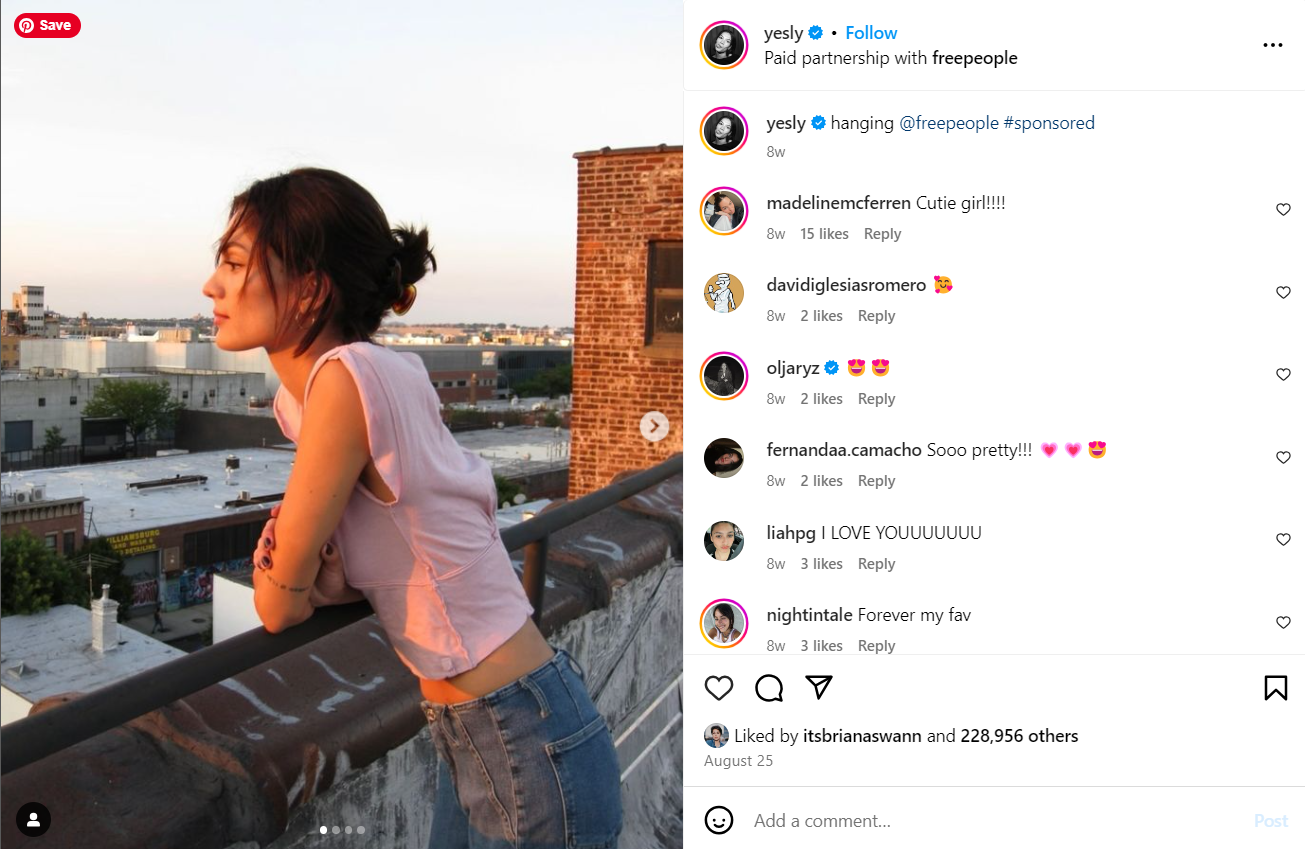
Another example is Yesly Dimate wearing Free People clothing in this post, which generated over 200,000 likes and hundreds of comments–substantially more than Free People usually gets on their posts. Plus, Free People reposted her photos as UGC and got even more mileage!
But product placement isn’t only limited to engagement and visibility. It can also make a considerable difference in sales.
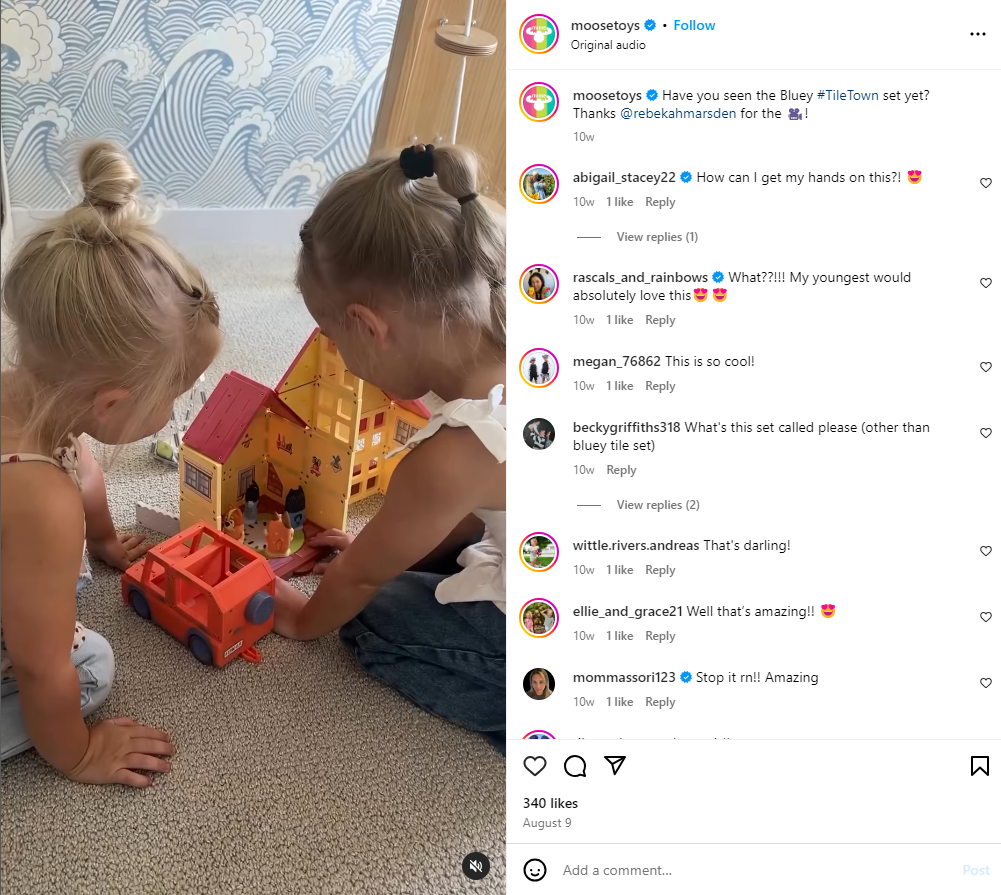
One of our brand partners, Off the Farm, worked with over 80 influencers on Social Cat, and they’ve had a six-figure ROI. Matching with influencers who are a good brand/product fit can make a huge difference–and this is just one of many influencer marketing examples from brands we’ve worked with who’ve seen an increase in sales once they found the right influencers to do product placement!
Unboxing and Review Campaigns
Unboxing and review-based influencer campaigns are great options if you’re looking to create authentic connections with audiences. Here’s why:
Consumers are more and more distrustful of traditional marketing messages. They don’t believe your highly-edited product shots and commercialized videos. They want to know what your product is actually like.
And the best first step toward showing them is letting them hear about it from someone they trust. Influencer content can be the first bridge that opens a potential customer’s eyes to the possibilities of using and enjoying your product.
This is especially true if you’re an e-commerce brand or you’re launching a new product. Because if potential customers have never seen your product for themselves, they won’t know what to think.
But put yourself in a potential customer’s shoes for a minute: If you log onto Instagram and see someone opening a box, you want to see what’s inside, right?
That’s one of the first hooks with unboxing videos–people are curious and want to watch to the end.
But then, once the product is unboxed, the influencer can show all the little details about your product that people might miss while reading a product review. They can see how it looks, how it works, and how to use it.
…And once they see that, you can be they’re going to be hooked. They’ll want to learn more and potentially get it for themselves.
Review videos don’t necessarily pique viewers’ curiosity in the same way, but they help create authentic connections with audiences and increase the conversion rates of posts.
After all, if someone sees an influencer they love sharing about a product that solves a problem that they have, they will want to see what the influencer says.
Will they love it? Hate it? What will they say are the pros and cons?
When you hire influencers to review your videos, you can give them a list of selling points you’d like them to cover–just make sure you give them enough creative freedom to review it how they’d like. People are suspicious of sponsored posts, so you need to let the influencer be their authentic selves if the review will drive connections and conversions.
Giveaways and contests
If you’re hoping to run giveaways or contests for your brand–possibly to start generating UGC–influencers can help make them successful.
Think about it: for people to participate, they need to hear about your contest or giveaway. They also have to feel that it isn’t ridiculous for them to participate–that it’s worth their time and that other people are doing it too.
Influencers solve all three problems:
✅ They’ll get the word out about your contests or giveaways.
✅ They’ll lead by example and show people how to participate by participating.
✅ They’ll convince people that it’s worth their time to enter.
Plus, influencers can boost engagement for contests and giveaways, attracting new followers to your page so you get even more participation.
These are excellent reasons to get influencers involved in your giveaways or contests. If you’re not sure where to get started, here’s how to run a giveaway or contest with influencers:
- Define your goals. We discussed this a bit previously, but before you start building a contest or giveaway, you need to know your goals and who you’re trying to reach.
- Choose a format. There are SO MANY different kinds of contests and giveaways you can run. You can run photo or video contests to get UGC, do a random draw if you’re trying to grow your following, and mix it up with fun games or trivia. You’ll also need to choose a prize that meshes with your audience’s interests and your brand.
- Clarify rules. Based on your goals and format, define how participants can enter, decide how long the contest will run, and ensure you align with local laws and platform guidelines. For example, many places have laws limiting raffles, so make sure your contest is in the clear.
- Create supporting content. Before you launch your contest or giveaway, think through what you’ll need. Write out the rules clearly and concisely. Decide what, if any, visuals you’ll need for your campaign, and get those too. If the giveaway or contest hinges on a particular page on your website or post on your social media, get that queued up and ready to publish.
- Partner with influencers. Now that you have your ducks in a row, it’s time to get influencers on board! Look for influencers who align with your brand values and goals for your current marketing campaigns–the goals you defined at the beginning of this process. Reach out and discuss terms that both of you can agree on. Some influencers may want free products and a commission for the number of entries, while others may want a payment. Figure out what works for your brand and the influencers who will help drive engagement in your contest or giveaway.
- Launch and promote the contest or giveaway. Now, you’re finally ready to make this contest or giveaway a reality! Share about it on your social channels, and have your influencers create posts or stories about the giveaway and tag your brand or use the event hashtag.
- Engage participants. Since you’ve launched, you might think you can just sit back–think again! You’ll see the most engagement if you continuously engage with those who enter. Stay active in your comments section. Share updates, reminders, and some of your favorite entries to keep the excitement high.
- Announce the winner. Once the contest or giveaway ends, announce the winner based on your predetermined rules. Tag them on your social media accounts so people following along can get some closure–but also reach out to them directly to arrange how they’ll get their prize.
- Analyze and learn. You’re probably exhausted now, but take a few minutes to look at what you accomplished. Did you meet the goals you set out to meet? What feedback did you receive that you can implement next time?
- Thank participants and influencers. To encourage future participation–and get more traction out of this contest or giveaway–be sure to give shoutouts to people who participated and publicly thank the influencers who helped you. Stay in touch with your new followers and keep engaging with them once the event ends–that’s how you’ll see long-term gains.
And that’s it! That’s how influencer marketing can help you get more traction from your giveaways and contests.
Affiliate Campaigns
You can also hire influencers to be your commission-based sales team. How? By running an affiliate influencer marketing campaign.
Here’s how affiliate campaigns work:
You connect with an influencer and ask them to promote your product. For every product they sell, you’ll give them a cut of the profit. Usually, you’ll accomplish this by giving them a unique, trackable discount code that they can share with their audience, but you can also use affiliate links.
Either way, you’re tracking influencer marketing campaigns and paying based on their sales.
It’s genius. And it’s a way to guarantee that you only pay for posts that effectively sell your products. This means you’ll likely have a higher ROI with affiliate campaigns than with some of the other approaches.
Influencers like them, too, because their payout is often linked to the effort they’re willing to put in, and brands usually give them more creative freedom.
Here are a few examples of influencer marketing affiliate campaigns that worked out well for the brands and influencers:
- Fabletics uses influencers to promote their subscriptions, offering unique links and discounts if you do affiliate marketing for them. We can’t find any information on how it’s performed for Fabletics on the business side, but hundreds of influencers are promoting their products, and they’re still running it–so you can bet it’s making them good money!
- Blue Apron provides affiliate links to food bloggers who share their experiences using the meal kits. The campaign resulted in increased visibility and sales through personal recommendations.
- Fashion Nova collaborates with various influencers, providing them with affiliate links to promote specific items. Cardi B’s posts led to substantial traffic and sales, showcasing how effective influencer partnerships can be in the fashion industry.
Takeover Campaigns
You’ve probably seen an “influencer takeover” on Instagram. It’s when an influencer gets to post on behalf of the brand for a set amount of time–usually 1-2 days. Throughout that time, they were the brand's voice, talking about what the brand meant to them, how they were using it, or posting live during an event.
There has to be a lot of trust between you and the influencer if they have that much control over your social media. But when there’s synergy between your brand and the influencer’s vibe, takeover campaigns can be some of the best influencer marketing campaigns you (or rather, you and the influencer) will run for your brand.
Influencer takeovers create excitement because influencers will pump up their audience to join them on your channels. They’ll create exciting, time-sensitive content to boost engagement and interaction in their posts.
Another unexpected perk of influencer takeovers is that they create authenticity. Try as you might to maintain an authentic feel to your posts, there’s a level at which your content probably feels stuffy and corporate. After all, you must justify to your bosses why you posted something, so you’ll probably ensure everything is polished and safe.
Influencers don’t have to do that. It’s their job to show your products happening in real life–and to make that real life as appealing as possible. So, when you have influencer takeover campaigns, you’re opening the door for more authentic and creative content on your brand’s pages.
Some of the best influencer marketing campaigns from 2023 were takeover campaigns. Below, we’ve listed just a few examples.
Best Influencer Marketing Campaigns 2023:
- Fenty Beauty: Because Fenty emphasizes diverse skin tones, influencer takeovers have been the perfect medium for them. They’ve invited numerous beauty influencers, including James Charles and Jackie Aina, to take over their accounts and share tutorials and product reviews. Their influencer takeovers further emphasize the brand’s commitment to inclusivity.
- Burt's Bees: In 2023, Burt’s Bees collaborated with various beauty influencers for a week-long Instagram takeover. Each influencer showcased their favorite Burt's Bees products and how they incorporate them into their daily routines. The campaign emphasized authenticity and gave Burt’s Bees a ton of user-generated content to use in the future.
- Adobe: Adobe ran an artist takeover campaign on Instagram featuring digital artists and designers who used Adobe tools to create unique content. The artists shared their creative processes, driving engagement and interest in Adobe products.
Event Promotion and Coverage Campaigns
There are two main types of events you’ll need to promote:
In-person events–like store openings–and online events like launches.
Whether your event is in-person or online, influencers can help you generate buzz about what’s happening before, during, and after the event. They can drive interest in it and boost attendance and sales.
Here’s how that might work for in-person events:
- Give select influencers early access to your event space–whether we’re talking about a new store location or an event space–and have them post about it. Everyone likes a little behind-the-scenes content, and it’s a way to build excitement before your event even happens!
- Ask influencers to live stream their experiences with your event–whether that’s a sneak preview, during the event, or even wrapping up after.
- Collaborate with influencers to host giveaways for attendees, such as gift cards or exclusive products, incentivizing their followers to attend the event. We talked a little about running influencer giveaway campaigns earlier in this article, and it’s a great idea to combine them with event promotion when you can!
- Encourage influencers to share their thoughts on the event, products, and overall experience, providing authentic testimonials.
- Set up visually appealing backdrops or branded photo booths at the event. Influencers can take photos and encourage their followers to join in and share their experiences.
- Host mini-workshops or product demonstrations during the event. Influencers can post about their participation and encourage followers to learn and engage.
- Encourage influencers to share recap posts with highlights, their favorite moments, and shout-outs to other attendees. This will extend the event's reach and keep the buzz alive.
And it’d look like this for online events:
- Send influencers whatever you can to give them a sneak peek, and have them share teaser content leading up to the launch, such as unboxing videos or behind-the-scenes glimpses of the product development process.
- Collaborate with influencers to host live streams on platforms like Instagram, TikTok, or YouTube during the launch. This way, they can unveil the product, showcase its features, and answer audience questions in real time.
- Provide influencers with unique discount codes to share with their followers, encouraging immediate purchases during the launch. This is a way to bring affiliate marketing into this event campaign!
- Create a unique hashtag for the event and request that the influencers use it, increasing visibility and engagement during the event.
- Encourage influencers to share in-depth reviews and testimonials about the product after they’ve had time to use it, enhancing credibility.
Long-term Brand Ambassador Campaigns
One idea that can create BIG returns is picking a few influencers to become your brand ambassadors. This influencer strategy will not get you immediate results, but it can go a long way toward building trust with audiences over time.
Why?
Because when audiences see an influencer consistently promoting your brand over time, it adds credibility. They start to think, “Oh, maybe this isn’t just about the money–maybe this brand is as awesome as it seems!”
Consumer trust in brands is at an all-time low. So, anything you can do to build confidence in your brand will pay off in the long run. That’s why influencer marketing best practices often involve running a brand ambassadorship program.
For example, Chobani launched a brand ambassador program to promote its yogurt products through authentic storytelling. They invited nutritionists, chefs, and food bloggers to share recipes and tips using Chobani yogurt. These brand ambassadors received products to create content around their favorite ways to use Chobani.
Over time, this initiative increased brand visibility and customer engagement, with significant growth in social media followers and sales. Their brand ambassadors helped position Chobani as a versatile ingredient in healthy eating–and the rest is history. Greek yogurt has gone from being a novelty food item to a staple in all kinds of kitchens.
Best influencer marketing campaigns of 2024

If you’re looking for examples of influencer marketing campaigns to inspire your influencer strategy, this section is for you! We’ll go over 5 of the best influencer marketing campaigns from 2024 and talk about what we can learn from them.
Apple #ShotoniPhone
Campaign Type: Sponsorship Campaign
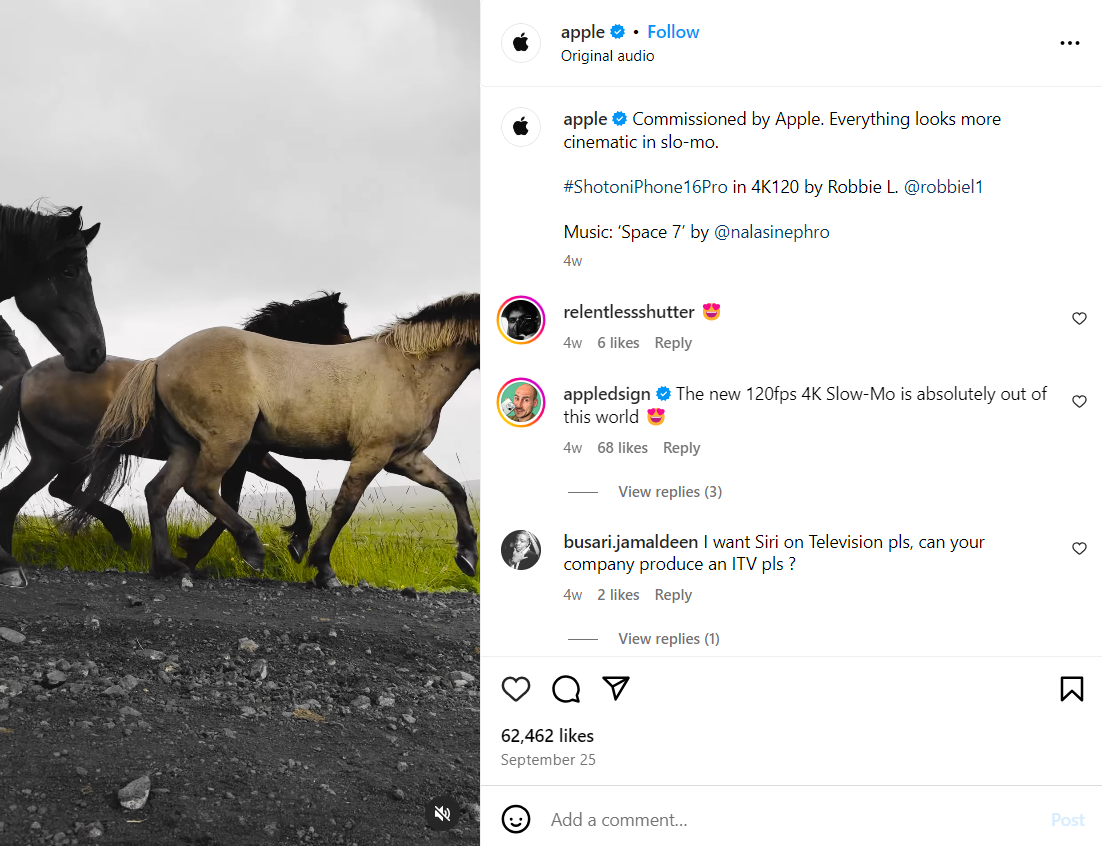
Apple has used the #ShotoniPhone campaign for years. It’s a great hashtag that promotes the quality of iPhone cameras. As a result of this campaign, Apple has received tons of UGC for its marketing.
But did you know they also commission photographers and influencers to use their phones to make content?
To promote the iPhone 16 in 2024, Apple commissioned videos and photos from different creators around the web to post to its social media channels. These expressions of creativity serve as a reminder of the innovation and artistry that Apple stands for. So far, the iPhone 16 has outsold the iPhone 15 by 20%.
Was that all due to the work of influencers? Probably not, but it contributed to raising awareness for the new product and creating excitement.
Oreja Linda’s Rebrand
Campaign type: Unboxing
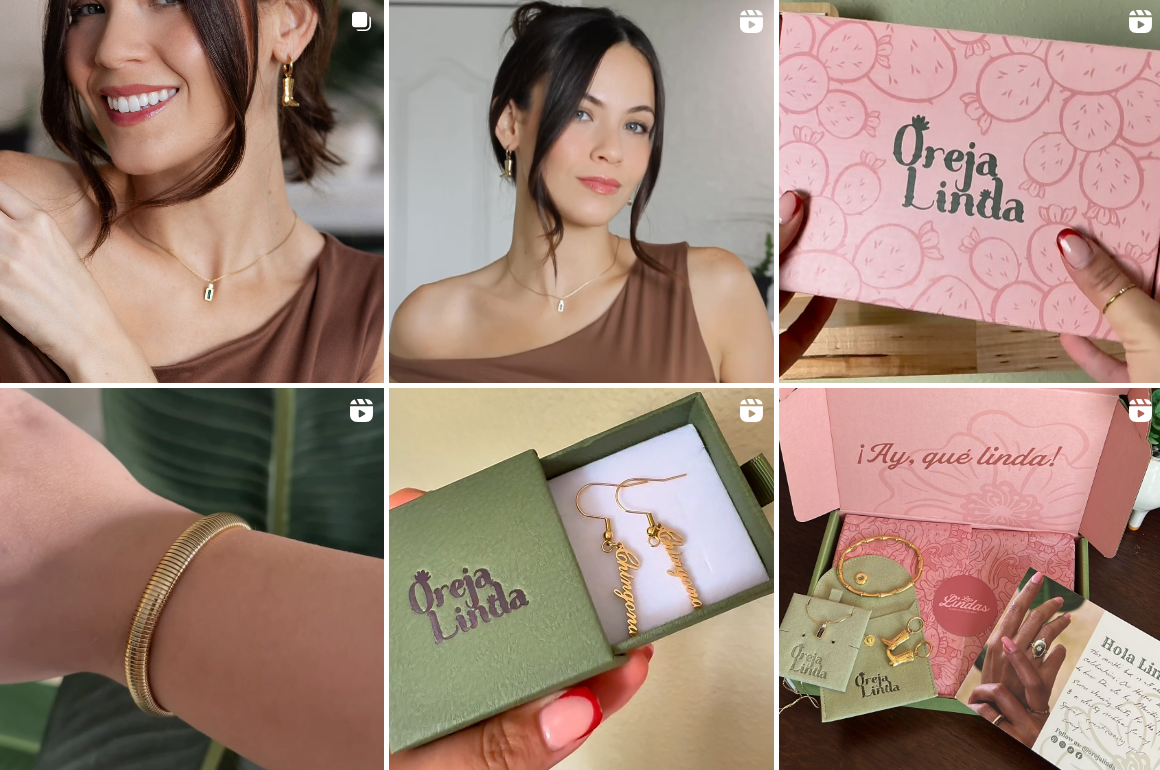
Oreja Linda is an e-commerce jewelry brand celebrating Latina heritage. They recently underwent a rebrand and hired a designer to create all-new packaging.
Why the emphasis on packaging?
They knew swoon-worthy packaging would help them create momentum when influencers shared their products!
They walked customers through the rebrand and, once it was completed, started working with nano and micro influencers to highlight the unboxing experience.
This campaign is new, so it’s hard to tell the outcome. But they’ve got it right–if you’re trying to build a luxury brand, your packaging makes a huge difference when influencers do unboxing campaigns for you.
Dove X Venus #KeepHerConfident
Campaign type: Contest/Giveaway & Brand Ambassadorship
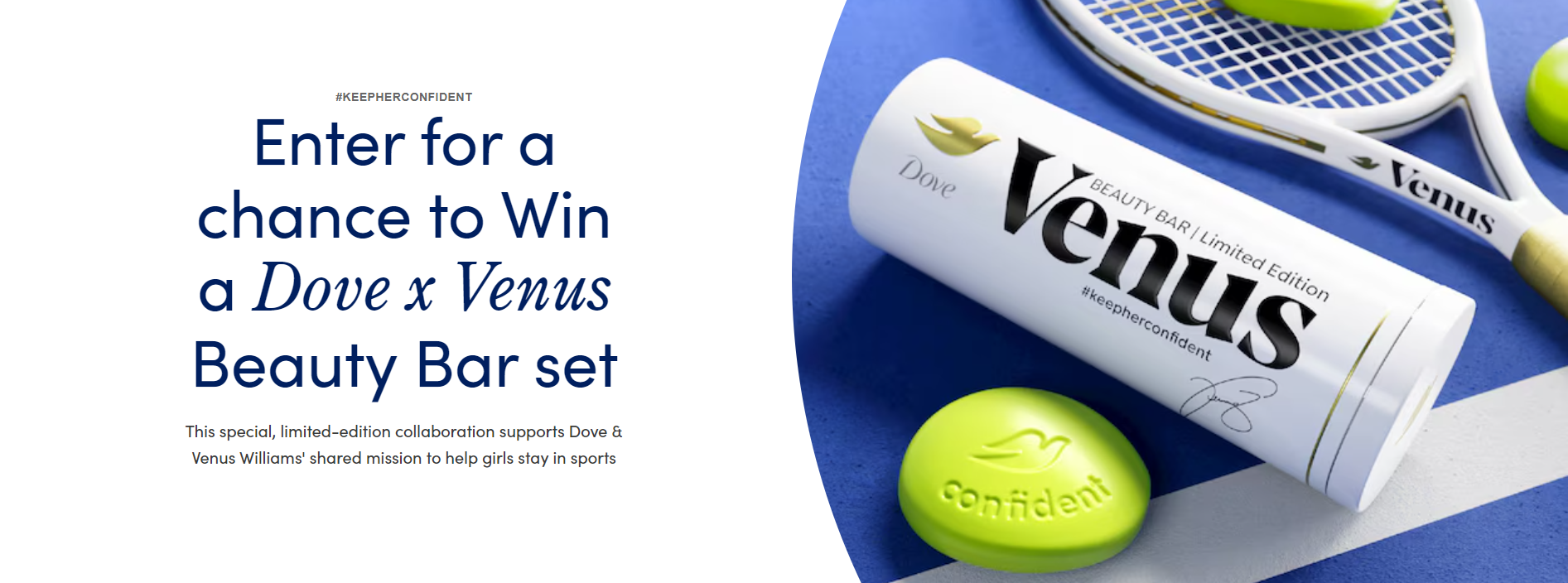
Dove launched a partnership with Venus Williams this year and held a contest where they gave away exclusive Venus Williams-created body bars.
But this wasn’t a product launch–the only way to get these limited-edition beauty bars was to enter the contest.
They were using the sweepstakes to increase brand awareness, expand their contact lists, and draw attention to the fact that 45% of women drop out of sports by age 14.
To enter, participants simply had to fill out a form with their contact information, and then a winner was randomly selected.
Along with the contest, Dove also gave away resources to parents and teachers on instilling body confidence in teenage girls. So, there were multiple reasons for people to visit their website, giving the contest visibility and momentum.
It also gave Dove new email addresses, physical addresses, and phone numbers they can use for future marketing.
Overall, the campaign was well received by the public, and it further cemented Dove's image as a pro-women and pro-girls brand. It was also a unique way to capitalize on Venus Williams being one of their brand ambassadors.
Target Circle Week
Campaign Type: Event promotion
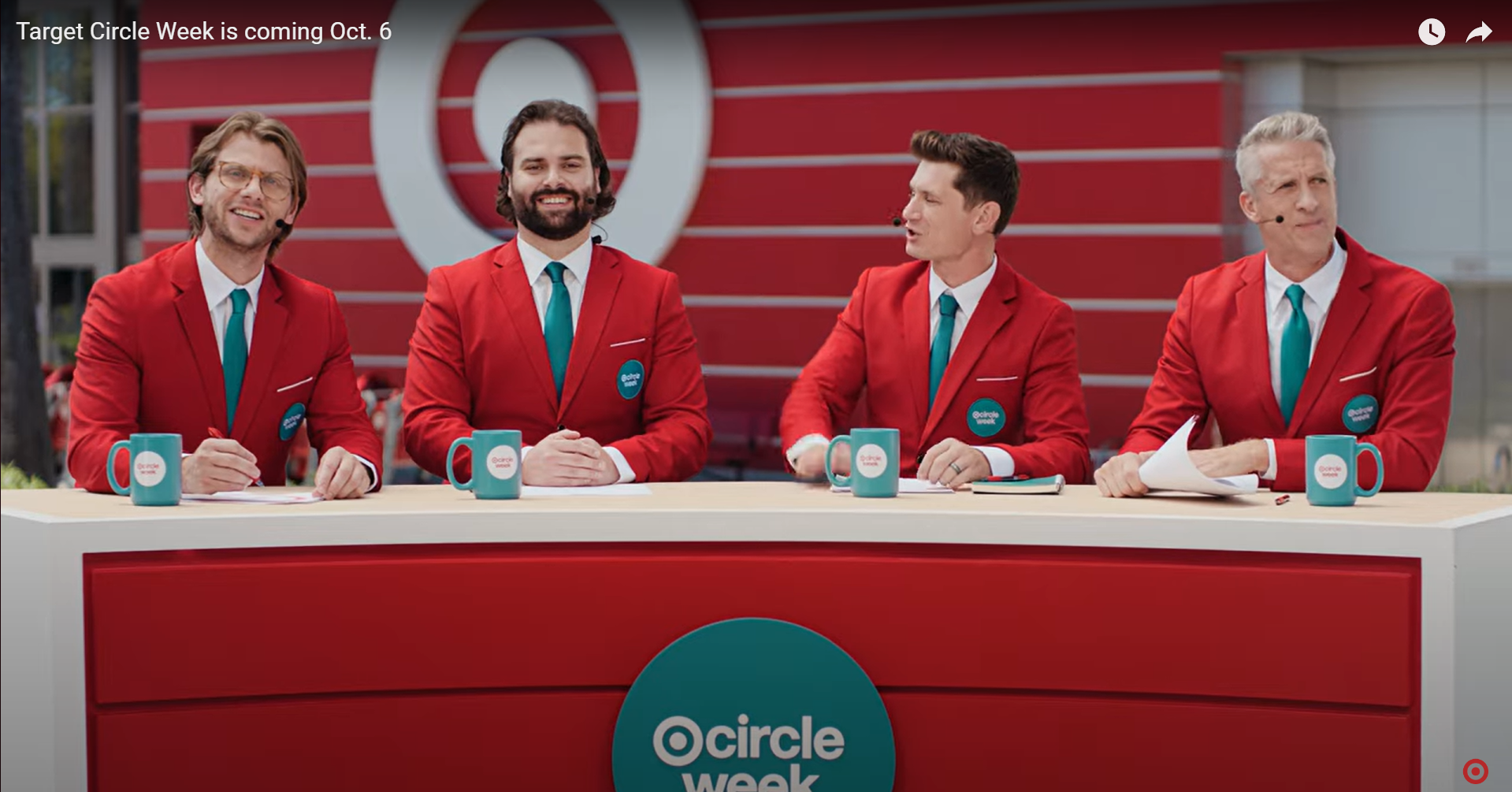
Target chose to promote 2024’s Target Circle Week by calling in some big-name influencers–a group of YouTubers who did a “Husbands of Target” video that went viral: Charlie Berens, Taylor Calmus, Penn Holderness, and Myles Montplaisir starred in Target’s commercial, but also promoted Target’s event on their individual social media pages and YouTube channels.
This campaign was a great melding of traditional advertising and influencer marketing campaigns–but I guess we’ll have to wait and see how Target’s Q4 reports look before we jump to conclusions about how this campaign performed! 😉
The Rookie Season Finale
Campaign type: Takeover, Event Coverage
ABC had actress Melissa O’Neil take over The Rookie’s Instagram account to promote The Rookie's season finale. Her reels, which shared behind-the-scenes looks at filming the finale, generated significant engagement for the show–they got about double the views of their regular posts.
Shows often have actors take over their accounts for the day because people are highly interested in the people who play their favorite characters. So, this isn’t a groundbreaking strategy–but it’s very effective if you can use something people are already excited about to create buzz around what your brand is doing.
Best practices for influencer marketing campaigns
Like most things in business, influencer campaigns are the most effective when you do them intentionally and analyze your results. Here are some of the best practices you can use to get the most out of your influencer marketing campaigns:
Planning and Execution
If you’re looking at a successful campaign, like the best influencer marketing campaigns of 2024 above, you can be sure it didn’t happen accidentally. Every successful campaign has a well-thought-out influencer strategy behind it.
So, to make your campaign a success, set up clear and actionable steps for the campaign from start to finish. Ask yourself:
- What’s my goal for this campaign?
- What’s my budget?
- What criteria will I use to select influencers?
- How will I find these influencers?
- How will I track my progress?
You’ll want to have answers to these questions before you get started. Break the process down, step-by-step, to understand what you must do at each point.
Tracking and Measuring Campaign Performance
Knowing what metrics matter to you is essential for setting the right goals, tracking progress, and assessing your campaign afterward. Tracking influencer marketing campaigns is most effective when your goals inform it.
So, with that in mind, here’s what you might need to track depending on your goals:
- If your main goal is to generate sales, track the things closest to sales to get a feel for how you’re doing. For example, registrations or people who’ve clicked “add to cart.” This might help you understand where people are falling off your sales funnel.
- If your main goal is to get a good ROI (return on investment), track your spending and the money it generates.
- If you’re trying to raise the engagement rate on your social media channels, look at the analytics on your account. Compare your engagement before the campaign to after the campaign.
- You'll want to track reach if your main goal is brand awareness. Yes, engagement tells a bit of that story, but reach is a much more accurate way to measure it. You need to know: How many individual users has this campaign reached? Now you know how many users are aware of your brand and products. Not all of them engaged with your post, so engagement isn’t telling you the whole story.
- If your main goal is generating UGC, track how many pieces of usable UGC you have.
What are the metrics or deliverables you’re going to track?
Common mistakes to avoid for influencer marketing campaigns
Brands tend to make many mistakes when collaborating with influencers–we’ve seen them all. Here are the most common ones so you can avoid them in your campaign:
- Failing to set specific, measurable goals. There’s a reason we’ve mentioned this in a couple of different ways in this article. If you aren’t crystal clear on what you’re trying to accomplish with your campaign, you can get distracted and lose focus. If you’re unsure how to measure your goals–i.e., how you’ll measure brand awareness–you’ll also have trouble evaluating how effective the campaign was. Instead of creating nebulous goals, set concrete targets like “increase Instagram followers by 20% in two months” or “generate 50 pieces of UGC.” Bottom line: If you can’t say, with certainty, whether or not you reached your goal after the campaign, your goals were specific or measurable enough.
- Underestimating costs. This is a big one. You’ll have to pay influencer fees, of course, but you also need to consider production costs, monitoring tools, and boosting content on social media platforms to maximize its reach and engagement. There are a lot of extra costs associated with influencer campaigns, so add a little extra to your budget.
- Choosing the wrong influencers to work with. Make sure the influencers you choose have audiences that fit your brand–also, check their engagement rates and the quality of their content. You can’t just pick the first influencer you find–they must be a good match for your brand.
- Being too restrictive with campaign guidelines. You’ll need to give influencers some room to play with–they are creators, after all! Restricting them by having too many rules will kill their creativity and leave you with dull, repetitive content. It’s much better to let them come up with different angles for presenting the information.
How to choose the right influencer marketing campaign for your brand
As always, you must choose your influencer marketing campaign strategy based on your brand goals.
Here’s how to choose the right type of influencer marketing campaign according to those goals. ⬇️
Awareness
If your brand’s goal is awareness, you’re trying to increase your brand’s visibility and reach a wider audience.
Types of influencer marketing campaigns that drive awareness are:
- Product placements and sponsorships. Collaborating with influencers to feature your products in their everyday content can increase your brand's visibility.
- Takeover campaigns. Having influencers take over your brand’s social media for a few days creates a unique experience for their followers and drives new traffic to your channels.
To measure awareness, here’s what you’ll want to track:
- Reach. You can track impressions too, but Reach will tell you the unique views, which is more helpful.
- Follower growth. More people following your social media channels indicates more people are becoming aware of you.
- Mentions or shares. People talking about you pushes your content into new people’s feeds.
- Engagement. Increased engagement with your brand’s socials indicates that more people know about you and are excited about your products and services.
Engagement
If engagement is your primary goal, you’re trying to deepen your brand’s connection with your audience, grow the number of interactions your brand has on social media, and encourage your customers to create and share user-generated content.
The influencer marketing campaigns that drive engagement are:
- Giveaways and contests. Run a contest or giveaway (or ask your influencers to!) and ask for engagement, like comments and shares.
- Unboxing and review campaigns. When influencers create unboxing and review videos, they start conversations about your brand with their audience, which prompts engagement.
To measure engagement, you’ll track:
- The engagement rate. Look at the number of likes, comments, shares, and saves the influencer’s post received. We know this probably seems like a given, but we couldn’t leave it out, could we?
- UGC creation. Track how many people created content around your brand in the given period. Many UGC posts indicate that your audience is engaged and wants to interact with your brand.
Sales
Obviously, if sales are your main priority, you want SALES! But there are things that go along with that, too, like driving conversions and maximizing your return on investment, that you can’t really afford to ignore.
Influencer marketing campaigns that drive sales include:
- Affiliate and discount code campaigns. When you provide an influencer with a unique affiliate discount code, you’re incentivizing them to sell your product for you. The more they sell, the more money they make. But you’re also incentivizing their audience to buy NOW because there’s a discount available.
- Long-term brand ambassador programs. When you partner with influencers for ongoing collaborations, you’ll establish trust and familiarity over time, leading to consistent sales. This one is more of a long-game approach.
For any sales-focused campaigns, you’ll want to track the following:
- Sales–yes, of course!
- ROI. You might be making sales, but you’ll also want to know which influencers helped you sell the most or made the most profit. See how your investment is paying off by running some ROI calculations.
- Conversion rate. If your sales are low, this is one of the first things you’ll want to check. People often don’t buy because there’s no apparent reason to buy right now.
Social Cat can also help with this. We have a network of more than 50,000 influencers on Instagram and TikTok looking for long-term ambassador programs. They work on gifted, paid, and affiliate campaigns with brands.
We focus on micro-influencers because they tend to be more authentic, engaged, and affordable than their bigger peers. If you’re interested in running influencer marketing campaigns that drive sales, you need to check it out.
Conclusion
When it comes to influencer marketing campaigns, there are a LOT of options. It’s easy to get overwhelmed or unfocused when you see all the possibilities, but we hope this article has helped you clarify your thoughts.
If you remember one thing about running influencer marketing campaigns from this article, make it this: The success of your influencer marketing campaigns depends on how well they align with your goals.
If you’re hoping to drive sales, don’t go with a giveaway or contest–those are much better at driving engagement. If you want UGC, don’t focus on creating a brand ambassadorship program just yet–focus on connecting with influencers who make great content.
If your goals aren’t defined in measurable terms, you’ll have no way of knowing whether your campaign succeeded. But your chances are good if you can focus on your goals and pick the right influencers and marketing campaign format.
You’ll probably want to bookmark this article to help you determine which type of campaign you need to run at different seasons in your brand’s life–and that’s okay! The influencer strategies we outlined in this article can help you sort through all the choices, no matter what.
When you’re ready to find influencers who can boost sales and scale your business, join Social Cat to connect with our community of vetted micro influencers. Their content is the best value for the price that you’ll find anywhere online.
Table of content
- What is an influencer marketing campaign?
- How do you define a successful influencer marketing campaign?
- What are the different types of influencer marketing campaigns?
- Best influencer marketing campaigns of 2024
- Best practices for influencer marketing campaigns
- How to choose the right influencer marketing campaign for your brand
- Conclusion
Looking for influencers?
Table of content
- What is an influencer marketing campaign?
- How do you define a successful influencer marketing campaign?
- What are the different types of influencer marketing campaigns?
- Best influencer marketing campaigns of 2024
- Best practices for influencer marketing campaigns
- How to choose the right influencer marketing campaign for your brand
- Conclusion

About Stefan A.
Stefan is a Growth Marketer turned founder with a background in customer acquisition, Influencer Marketing, and early-stage startups. At Social Cat, Stefan drives day-to-day operations and growth, helping small brands connect with the right influencers to scale their reach and impact.


